Finding the home design that matches you perfectly can be overwhelming. If you find yourself struggling to to find inspiration, take a look at these popular trends seen across the world.
Scandinavia
Lagom—the Swedish word for just the right amount, the perfect amount, not too much and not too little. This singular word has become an intimate word in Swedish culture and there have been several books written about its impact on lifestyle.
Trends in Scandinavian design encompass lagom, striking a balance between minimalism and functionality. It’s popular to see simple clean lines and geometric shapes.
In fact, the resurgence of mid-century modern design was perfected and popularized by the Danes and Swedes.
Intellectualism is another facet of Scandinavian design. Norse people are also well known for the amount of books they read. What better way to spend your fika, Swedish coffee break, than next to a collection of your favorite books. It’s not uncommon to see entire walls in the living room dedicated to books.
Many parts of these Nordic countries rarely see the sun set during the summer months. Although the summer is flooded with light and life, the winter months become extremely cold and dark. Minimalism, functionality, light colored pastels, and natural woods in Scandinavian design keep the home warm and cozy during the dark winter. — this is important because of the effect darkness has on mood. Angle this point around how interior design is a way to keep moods elevated in the long winter months.
With Sweden, Denmark, and Norway all ranking in the top ten on the Global Creativity Index, it’s no wonder they lead the way in design innovation for home interiors. Thank you, IKEA (and no thank you for the self assembly).
 Scandinavian mid-century modern minimalism
Scandinavian mid-century modern minimalism
Italy
Italian design is inspired by the meeting of two worlds—the old and the new. The Italians are prideful of their architecture and their design trends reflect that. Although many design choices are dominated by historical stone columns and elegant craftsmanship, there are also modern industrial finishes.
In Torino and Milano, the industrial capitals of Italy, you’ll find features of traditional woods, stones, and fabrics, along with industrial elements like large glass panels and metal frames.
The dichotomy of modern and traditional, subtle and intense, are the foundation for Italian design. The art of Italian design begins with history preservation while bringing them to life with innovation. This is a story of old an new.
 Rustic Italian with traditional accents
Rustic Italian with traditional accents
France
Chic—the French word for elegantly and stylishly fashionable.
Just as the Italians, the French also have a story to tell, which can be told through the history and charm of the many craftful Parisian apartments.
While the architecture and craftsmanship of the home are vital for the French design, individualism is just as important. The essence of French design is centered around reflecting yourself in your home through the inspiration of your memories. Be prideful, boast a bit, and stand out.
Another aspect of French interior design involves deviating away from neutral hues and embracing vivid colors. Any color that speaks to you. Let it be noticed.
Whether it’s the rich architecture, antique furniture, or vintage decor, French elegance is built by the past.

Elegant French window opening
China
Peace, harmony, and serenity are the elements of Chinese interior design. These elements can be found through the fundamental principle of simplicity. Like the Swedish word lagom, the word feng shui, which encompasses balance, inspires Asian design. Feng shui is balance through symmetry and balance through placement.
From furniture to lighting, proper placement of belongings are the key to a feng shui inspired Chinese home. In fact, correct bed placement is said to offer both security and better sleep. The foot of the bed is to never be directly facing the doorway, but should have a clear view of it, as well as the windows.
Lighting is also another essential element of feng shui. Because of the sunrise, east facing windows will offer more energy in the morning, whereas west facing windows will offer the same effect during the evening.
Feng shui also considers the balance of colors. Not to be confused with which colors balance together, but which color balances with your own personality the most. Green is said to improve health and family life. Blue will help support the growth of your career. Yellow will invoke happy and bright feelings. Lastly, purple will help incubate creativity and supportive energy.
Feng shui is the system of laws that govern spatial arrangement and orientation in the relation to the flow of energy. The simplicity of Chinese design helps navigate the balance in life.
 Simplistic and balanced Chinese Design
Simplistic and balanced Chinese Design
There is no right or wrong way of designing your home. Your home should reflect perfectly who you are and you style.








